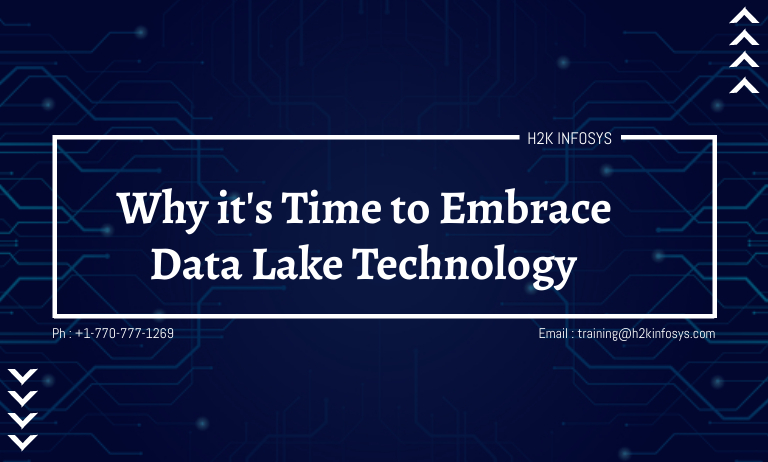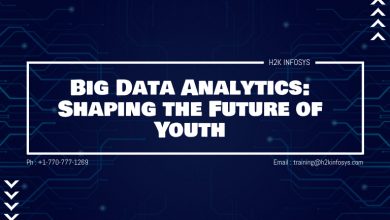Why it’s Time to Embrace Data Lake Technology

Data analytics and business intelligence (BI) initiatives were deprioritized by nearly half of IT leaders last year due to shifting priorities. Data analytics and business intelligence are moving back to the top of companies’ priority lists now that they’ve adjusted. This year, 55% of companies intend to spend money on data analytics and business intelligence software.
Companies must be strategic from the start of their efforts to become more data-driven. You won’t be able to develop insights that will help you surpass the competition if your company isn’t careful about how it keeps and analyzes data. Cutting-edge enterprises are using data lake technology to gain control and produce a profit. As the demand for big data experts increases, there is a need for individuals to learn the skill through online big data training.
Companies can no longer rely on spreadsheet-based data storage and analysis because of the volume of data and data sources. Spreadsheets provide a limited and backward-looking perspective of your data, are prone to errors, and take time to update.
Every company claims to want to be data-driven, yet many fail to get beyond data gathering and storage due to the perceived difficulty. A company’s data is never analyzed 60 percent to 73 percent of the time. If you’re not going to use it, why waste the time and money gathering it?
Enterprises require a better, more effective approach to managing the information they acquire, with more data arriving from various sources than ever before.
What exactly is Data Lake?
A data lake is a centralized cloud storage place that can hold vast amounts of raw data in its original format from a variety of sources. Data lakes should be considered as a feasible option for both data management and analysis by IT leaders.
According to Aberdeen, he discovered that companies with excellent data lake policies had a 9% increase in organic sales growth.
There are several reasons why it’s Time to embrace data lakes as perceived by data analysts. Let’s take a glance at a few of these reasons below:
- A centralized database
You can only gain insights if you analyze data from a few sources. Every year, the average company expands its data sources by 50%, and the most competitive companies take advantage of this wealth of data.
Regardless of whether data is housed in the cloud or on-premises, data lakes integrate information from numerous sources across the organization, such as your ERP, CRM, HR systems, or IoT devices. Data centralization improves data accuracy, lowers data silos, and eliminates manual data entry, allowing your team to focus on higher-value tasks like the analysis. For a digital business, a uniform infrastructure is required.
Today’s organizations require a single repository that can handle data across environments and then function as a mechanism for distributing insights and information to users and applications in order to take advantage of data and transform it into actionable insights.
A data lake provides organizations with quick and contextualized access to the data they require. They’ll be able to develop analytics that points to changes in customer behavior, investment opportunities, riskier actions, and emerging market trends in this way.
- Convenient access
A data lake’s capacity to assist users rapidly and easily examine a large amount of data is one of its most enticing features. As a result of their data lake procedures, businesses with leading data lake practices are three times more likely to report a “strong” or “highly effective” go-to-market process. Data preparation, retrieval, and analysis are significantly easier with a data lake because data is stored in its natural format. In contrast to spreadsheets or data warehouses, where the data entered must be standardized, data preparation is minimal. Data retrieval does not require specific search parameters, making data access and extraction easier.
- Cost-effective
A data lake, unlike a data warehouse, uses a flat design to store data rather than a hierarchical system of files or folders. Organizations can scale storage as they grow, making it more cost-effective and easier to implement. This means no large upfront investment and no months of development time.
By offloading capacity from existing legacy systems, data lake technology increases the functionality of your ecosystem. This is especially enticing to larger, more established businesses that have invested heavily in data warehouse and mainframe systems in the past.
- Trendy Capabilities
Enterprises can apply innovative and complex analytical approaches thanks to data lakes. Machine learning and artificial intelligence (AI) can be used to clean and enrich incoming data, run complex algorithms to correlate many sources of data, and use predictive analytics. Over time, your insights will evolve and provide even more value to your company.
A data lake, however, has the potential to become a data swamp if it lacks sufficient governance and protocols. A data lake can become unreachable to end users if it is not handled properly. Work with a trustworthy advisor from the start to ensure that clear protocols and duties are in place.
- Providing better decision-making and growth opportunities.
While businesses are producing more rich digital data than ever before, data alone does not equate to growth. Organizations must take advantage of cloud computing improvements to enable more efficient and complicated data storage and processing. Data lakes allow businesses to acquire more data from more sources in less time and at a lower cost. These data storage solutions, when properly implemented, can result in improved business analytics and speedier decision-making, allowing your company to become data-driven.
- The Organization of Data
Traditional data architectures require that a database structure be designed in advance. Prior to processing and loading data into a physical database, data architects use a procedure known as “schema on write” to prescriptively model and define it.
Companies, on the other hand, are increasingly in need of an architecture that allows users to dynamically access and arrange data on the fly; this is known as “schema on read” or “late-binding execution.” It adopts the ELT approach, switching the load and transform processes such that the raw loaded data is cleaned and transformed in the data warehouse instead of using the typical data warehouse sequence extract, transform, load (ETL).
Conclusively, if you’re wondering when exactly is the time to embrace the data lake. The time is now and the reasons are as explained above. You can learn about data lake, data warehousing and ETL processes by enrolling in a big data certification course.





